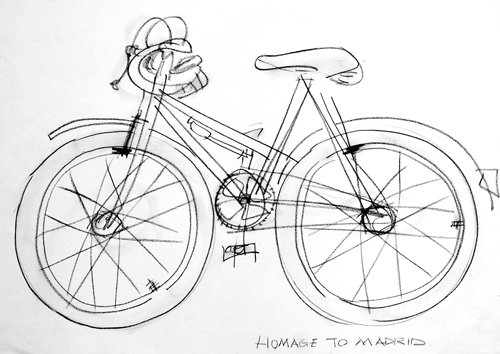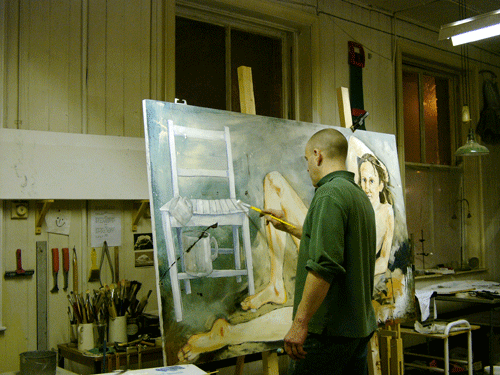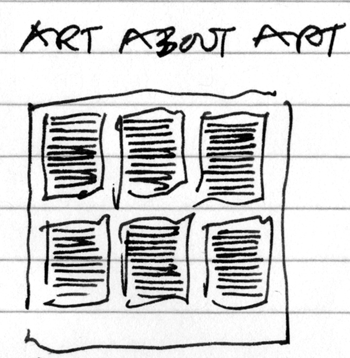ę December 2004 | Main | February 2005 Ľ
January 25, 2005
the passion
This isnít riding a bike.
Itís not just about putting down the shape and filling in the form. It isnít even just a case of looking and seeing. Not that these skills arenít vital to the aim, they are. Theyíre not to be overlooked, theyíre necessary if you have a passion you want to express.
Skills of looking and seeing, skills of handling tones and tints, of big and small brushes, of composition and perspective and shape and form and proportion. These are the tools with which to express the passion.
I donít just fill in shapes with coloured paint. I do fill in shapes with coloured paint, clearly, but I struggle with other things. Things I donít fully understand. The IT of a picture. The thing that brings it above painting by numbers, or copying, or merely pushing paint.
When I paint I feel the whole thing. I paint every part of the figure at the same time. I bring the whole thing up off the ground like a photograph developing in a tray. I feel something bigger than the figure, something extending from them, something emanating from them, some quality of light and strength, some power.
When the paint is oily on the palette and the brushes are loaded with their own colourful history, something happens. Everything contributes, the model, the music, the company, the light Ė especially the light, and the pose, to bring the picture close to an image I have in my head.
But the image is not fully formed, itís fleeting, obscure, itís a feeling as much as a picture, itís what I aim for in a painting, what I struggle to achieve. And I canít help thinking cyclingís a lot easier.

Posted by john at 10:18 PM | Comments (0) | TrackBack
January 18, 2005
late night tuesday night
Usually this sort of thing is reserved for the weekly studio update on the main site, but, hell, life's too short to take two sugars in tea ALL the time.

some questions arise -
Why the white chair again?
What are the mugs doing there?
Why is there a black splat across the chair?
Does it come from that brush on the left?
Why has he got the short hair style?
What kind of music is he listening to anyway?
The answer to these and many other questions are to be found in these pages from here on in, so stay tuned and all will be revealed [honest]
THIS POST HAS BEEN PUBLISHED WITHOUT THE AID OF A SAFETY NET OR A SPELL-CHECKER
the author accepts no responsibility for anything, contrary to his mother's expectations
Posted by john at 09:13 PM | Comments (0) | TrackBack
January 17, 2005
get with the medium
Iíve got to get into bulk. Bulk in the backgrounds. Drips and splats are all very well, but I want to get some bulk on the panels. Large amounts of thick paint, shrivelled and tortured textures, smooth and solid textures. History.
Iíve got bulk on the panels before, and highly successful it has been. But itís hard to do. Itís easy to do, so itís hard to justify. Painting a figure is hard, and as a result itís easy to justify. So because itís hard, itís easy to spend my time doing it. Hard Work, good old hard work, the struggle Ė got to be worthwhile. Getting bulky media together is, dare I say it, quite fun. Mud pies and playing with sticky is and always has been enjoyable. So to spend my time mixing up a mess of oil and paint is hard.
Posted by john at 11:01 AM | Comments (0) | TrackBack
January 15, 2005
Putting the brush about a bit
The figures are one thing, and thereís a whole lot of knowledge to be had in there. I work at a figure until I know it. I work with a figure until it becomes instinctive, or as near as instinctive as makes no odds. Because the brushes are alien. The brushes are as different from the panel as the flat surface of the panel is different from the three dimensions of the figure. So I need to be totally familiar with the figure and its intricate make up, to be able to let go completely and let the brushes take the paint and give it life on the panel.
But the backgrounds Ė now thereís something different again.
Donít get me wrong, it isnít as if theyíre not important, or enjoyable, they are. Itís just that theyíre totally different from the whole figure painting thing. Iím on my own in the studio when I do backgrounds for a start. No compulsion to paint, just frightening freedom.
Oh, and there are tricks, sure: reds comes forward, blues recede, all that good stuff. All the makings of depth and significance. Thereís even a hint of history to be had in the background. So here are a few background details to dwell on.
Posted by john at 11:51 AM | Comments (0) | TrackBack
January 12, 2005
Significance and intent
A piece should have significance and intent, or the why and what for factor, WWFF Ė if youíre into the whole abbreviation thing.
Significance is a personal thing, the why of it Ė why I am doing the piece. The significance can be hard to find, my painting is driven by a passion to put down an image, and when people say: ďwhy did you paint that?Ē I canít tell them, I canít come out with a long winded explanation, I donít do art-bollocks. I could. I could talk about the surface non-surface interface creating a dialogue between the image and the deconstructed picture plane.
But I donít, Iím old fashioned and adopt the Beckett approach to creativity. When asked why he wrote Waiting For Godot, Samuel replied that he didnít know, when asked what it means he said again he didnít know, everything he knows about the play he wrote in the play.
The painting is the painting, Everything I feel about the painting is in the painting, if it wasnít the painting wouldnít be complete. The significance of the picture therefore is the pictureís existence. [Pick the bones out of that Jean-Paul.]
Intent is possibly more external. What do I paint for? I feel I should paint to earn money, a hang-up from the Protestant Work Ethic, but as my pictures have yet to find their market [if you know of anyone who wants an eight foot wide by four foot high nude on their wall, let me know] I canít say my painting earns me a living. In many ways this is a Good Thing as it gives me creative freedom. [That the children have no shoes is another issue.]
I paint to express myself. I paint to communicate feelings and emotions and throw a brief light onto a dark corner of our lives, illuminating some facet of our intriguing existence. And I seem to be driven to it. It excites me. When painting, with a naked model, north light, big brushes and a free flowing palette, I feel fulfilled and happy.
Posted by john at 12:21 PM | Comments (0) | TrackBack
January 08, 2005
art as experience
So, time was, art was a craft. Not Ďny more, it ainít. Today art is what you do: art as experience. Tracey Emin, after a two week bender, ensconced in her bed, came back into her bedroom after a much needed visit to the bathroom and saw her bed, with the ash tray and the empty vodka bottles and the dirty knickers and crumpled sheets and saw it as art Ė and the rest, as they say, is history.

Today Art is about Art. Art is about being an artist. As Iím sure Iíve said in these diaries before, today you can say: ďI am an artist, therefore everything I do is artĒ. Whereas [time was] you did art and then said you were an artist.
But to be an artist treating your life as art only works if youíve got contacts. Only if you can get your life as art into the gallery. For one of the prerequisites of art-as-experience is that it only exists as art so long as someone puts it in an art gallery.
In a bedroom a bed is a bed, lying in the street a bed is a bed, but in the Tate Gallery a bed is art. A drawing on the kitchen table is art, a drawing on the pavement is art, a drawing in the Tate Gallery is art.
So if your art-as-experience doesnít make it to the hallowed halls of a national gallery [or sometimes even a provincial once] than sadly it just remains experience and does not rise to the level of art.
Posted by john at 03:51 PM | Comments (0) | TrackBack
January 07, 2005
Effortlessness
What is it about a picture that makes it work?
One thing is its apparent effortlessness, as if it has always existed, containing a history and a resonance.
But itís not just the one thing - there isnít a formula. A computer and robot can make a car but they canít paint a picture. [Ok so they can paint a picture but it ainít art, baby!]
In the fifteenth century, as the mysteries of science and mathematics were being revealed by the learned scholars, artists sought the Golden Key: the formula for a successful painting.
Their search was fruitless. There is no Golden Key. Just a whole pile of contradictory information. At its most fundamental, art is subjective, what Paul might quite like, Pauline thinks is dross. As two old ladies I overheard in an exhibition in Yorkshire, put it: ďI like it, but I donít know if I like it enough to want it.Ē
When an exhibition can comprise of an empty gallery [painted white], never mind The Bricks and The Bed, then anything is art. The important thing is: anything can be art, but everything isnít art. If everything is art, as I said to Monty over the cooker in Leeds, all those years ago, then art doesnít exist.
So all we have left is expression. Art has long since stopped being a craft. Art has left the High Street, where people bought carrots, ordered a new table and called in at the artistís studio to see how the portrait was coming along; and disappeared up the back-stairs into the garret.
This transhumance was largely due to the teachings of Joshua Reynolds, and partly due to the advent of the camera. Today we are free to do what we want. And what constitutes art is anyoneís guess; though money and art bollocks have a lot to do with it.
To be continuedÖ
Posted by john at 06:32 PM | Comments (0) | TrackBack